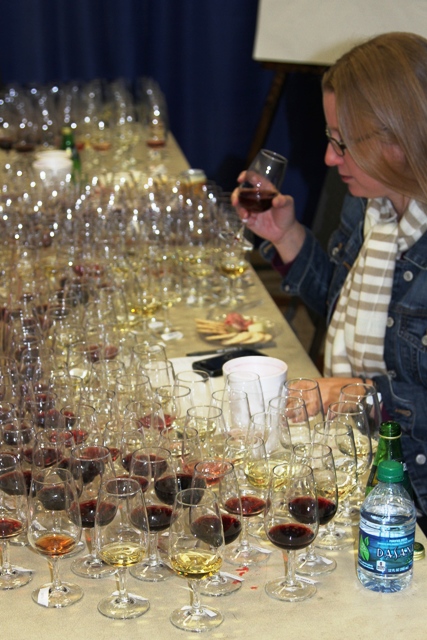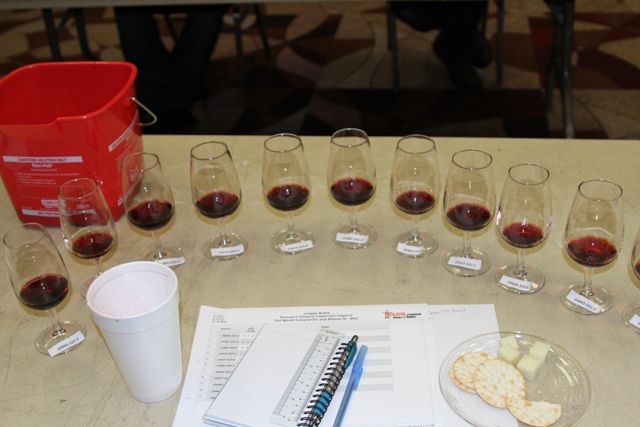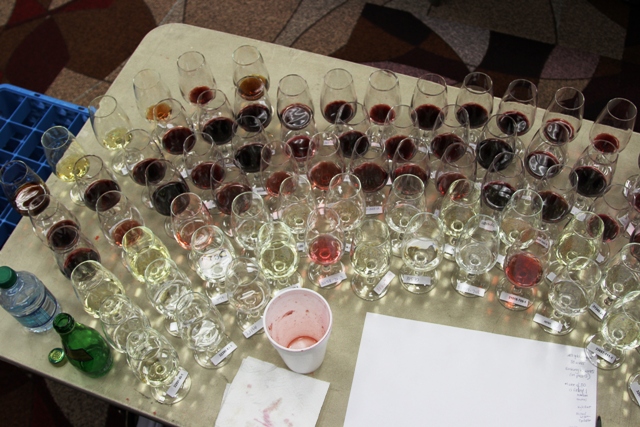For the next two days I’ll be judging wines with 99 other judges for the Houston Livestock Show & Rodeo for my third year in a row.
I can’t wear lipstick or anything with a fragrance. Nothing. And I’ll be in a room that’s about 65 degrees Fahrenheit.
Wanna what happens behind the scenes? I’ve got the inside scoop for you…

We’ll start with who I am and why I get to judge.
I taste a LOT of wine. Since launching my wine blog and working on the VineSleuth iPhone app, Wine4.Me, I’ve been tasting about 3,000 wines each year. I evaluate and learn about wines at Houston Sommelier Association meetings, at wine dinners and lunches hosted by wineries and distributors, at other trade tastings, at wine conferences, on press trips, through samples sent to me for review and, of course, in my own enjoyment of wines with friends and family. And then there are all of those wine evaluations for Wine4.Me! These experiences help me to be a better judge for wine competitions such as the Houston Livestock Show & Rodeo and the California State Fair.
What happens before the judging?
Each competition has a brief judge training session prior to judging to be sure the judges understand the objectives of the competition. Sometimes different competitions have different aims. The Houston Livestock Show and Rodeo aims to honor delicious wines that Houstonians are sure to enjoy- and give medals to those which are especially appealing and sure to be crowd-pleasers with that extra edge.
Before that training session, though, the competition collects entries from wineries. The HLS&R competition usually receives about 3,000 different wines to be judged in a variety of categories. Wineries pay fees to be included in the competition and those fees go toward the millions of dollars in scholarships the HLS&R awards.
Do the judges know what wines they are tasting?
As a wine judge, we have absolutely no idea of the specific wines we are tasting. We know the variety (type of grape) and a price range, but we do not know the specific brand of any wine. A lot of work goes into making sure this is the case.
The competition area is divided into three zones to keep wine identity secure. There is the back room, where the wine is poured into glasses labeled with numerical codes to identify the wines, the neutral zone where the wine is handed off to the serving team and then the judging area where the wine is served and judged. The people that bring us the wines to judge don’t even know what wines they are serving us. Because the judges do not know what we are tasting, this is called ‘blind’ judging and it ensures fairness.

What happens during judging?
For the HLS&R, judges are placed on panels of five with each panel judging up to 100 wines on the first day, and fewer on the second day.
People bring us flights, or collections of wines that typically have about 12 glasses of wine with about two ounces in each glass. The glasses are identified by a long string of numbers. Each judge tastes and evaluates each wine individually, determining what medal to award each wine, and then the panel discusses the wines as needed to determine final medal award-winners in each category, as well as double-gold winners.
To determine the absolute best of the best, competitions have a ‘super panel’ to judge the top-scoring wines and recognize winners such as Best of Show. For the HLS&R, there is a super panel of 23 judges which meets after the initial judging finishes on the second day. Each judge is poured the top wines to select the top winners in a variety of categories including best red, white, sparkling, value, Texas wine, and best wine from the featured region.
Judging in super panel the first time was a bit nerve-wracking, to be honest, as the table in front of me filled with wine glasses and I wondered how I would keep them all straight. Soon there were about 100 wines in front of me, all delicious, and it was up to me to pick the best of the best. Once I got to work, sniffing and tasting, making notes here and there, the judging part kicked in at it was easy to pick out my favorites, as well as what I thought Houston wine drinkers would love.
Serving on super panel is an exciting time—this year I was sad to have to skip it. (I had to skip it head to the airport to attend a wine conference in London, so it wasn’t such a bad trade off.)

How do you stay sober and keep your palate fresh?
Spitting is absolutely required. Yep, it’s true—we don’t swallow all those delicious wines. Instead we swirl, smell, sip, swirl in our mouths… and spit.
When you are tasting so many wines it is critical to keep your palate and head fresh. Consuming alcohol will impair that, so spitting is essential.
I make it a point to drink extra water for the day leading up to an evaluation and also drink a lot of water during an evaluation. Then, of course, I spit after every taste.
I also try to drink some sparkling water a few times during an evaluation—the bubbles seem to refresh my tongue. I also eat a bit of cheese and sometimes olives to cut the acid from the wines. (The California State Fair gives us the best olives from Graber’s while we judge… I think I am addicted to them!)
At the end of judging, it is most often a can of beer that wine judges reach for rather than another glass of wine. Again, those bubbles seem to refresh our tongues.
Judging wine is a fantastic way to experience a lot of wines at one time and test your palate. Plus, it’s a blast to be with so many others who enjoy wines and share stories between flights. (There is a LOT of waiting time involved in judging, as score sheets are checked and verified to be sure everything is accurate.)
I also enjoy serving as a wine judge because it is exciting to be a part of a group who gets to choose wines which you know others will enjoy. I love sharing my love of wine with others and helping to make wine more approachable (Why else would I have developed Wine4. Me??). Serving as a wine judge is another way I can do that.
What about that no lipstick or fragrance thing?
So much about you taste in wine is actually what you smell. In evaluating wines, it is critical that we are only influenced by the wines, and not our perfume or other fragrances. Any outside smells could throw off the assessment. Because if this, I can’t wear any fragranced anything when working. (So when I do wear perfume or gorgeous-smelling lotions on date nights, I really feel wild and free. :) )
Lipstick can also impact taste, plus it leaves a residue on the glasses which just isn’t nice. Those cleaning our glasses already have a lot of work to do. I don’t want to add to their work by leaving my mark on the glasses. And, of course, I don’t want to misjudge a taste or texture because of lipstick or lipgloss.
Like bundling up for cold weather? When judging wines, the rooms are kept as close to ‘cellar temperature’ to show the wines at their best. You’ll often see judges in fleece or scarves- even in the summer.
So… anyone else up for setting aside your fragrance and lipstick and spitting out hundreds of wine with me over a weekend? What about thousands over a year?
It’s all in a day’s work.

Leave a Reply